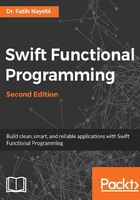
Custom operator definition
We can define custom operators using the following syntax:
operatorType operator operatorName { }
Here, operatorType can be one of the following:
- prefix
- infix
- postfix
Custom infix operators can also specify a precedence and an associativity:
infix operator operatorName { associativity left/right/none precedence}
The possible values for associativity are left, right, and none. Left-associative operators associate to the left if written next to other left-associative operators of the same precedence. Similarly, right-associative operators associate to the right if written next to other right-associative operators of the same precedence. Non-associative operators cannot be written next to other operators with the same precedence.
The associativity value defaults to none if it is not specified. The precedence value defaults to 100 if it is not specified.
Any custom operator defined with the preceding syntax will not have an existing meaning in Swift; therefore, a function with operatorName as its name should be defined and implemented. In the following section, we will examine an example of custom operator definition with its respective function definition.